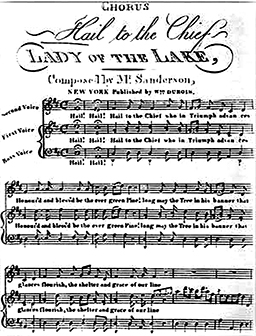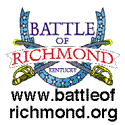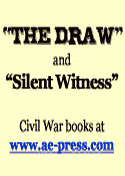|
'Hail to the Chief' was last music heard
by Civil War's assassinated president
By LINDA ASHLEY
Bugle Contributing Writer
The strains of “Hail to the Chief” filled Ford’s Theater the fateful night of April 14, 1865, as President and Mrs. Lincoln took their seats.
Only five days earlier, Gen. Robert E. Lee had surrendered to Gen. U.S. Grant, essentially ending the war, and so the crowd was happy and excited to greet the president.
The play, “Our American Cousin,” was in the third act when the southern sympathizer, John Wilkes Booth, entered the box where the Lincolns were sitting and shot the president in the head. Amid the cries and confusion, the band once again began playing “Hail to the Chief” as the president was carried out of the theater and across the street to the Peterson home, where he died the following morning. The tune, played so often in his honor, was the last music Lincoln heard.
Even before Lincoln’s time, however, the familiar song had long been played to announce the arrival of the president. An English composer, James Sanderson, wrote “Hail to the Chief” for a stage adaptation of Sir Walter Scott’s poem, “The Lady of the Lake,” and the melody first was performed in this country in 1812.
The Marine Band, the oldest musical organization in the United States, provides music for the president as its primary mission and has done so for every commander in chief except Washington. The band made its debut at the White House on New Year’s Day 1801 during the administration of John Adams, and played again at the inauguration of Thomas Jefferson on March 4 of that year. It is believed to have first played “Hail to the Chief” when President John Quincy Adams attended the dedication of the Chesapeake and Ohio Canal in 1828.
The song first was known to have been played at the White House during President Andrew Jackson’s administration (1829-1837). And, John Tyler’s wife requested that it be played at the White House on several occasions (1841-1845). However, it was not always played to announce the president’s appearance. In fact, it was played for all kinds of officials for any occasion. A mayor, an official of a lodge, or anyone else may be honored with the familiar tune.
James K. Polk (1845-1849) was a small, quiet, and unassuming man who often arrived at large functions without even being noticed. His wife, Sarah, suggested that his arrival be announced by the playing of “Hail to the Chief,” as a way of avoiding that embarrassment. That tradition has continued to this day.
Also, the tune was played for Confederate President Jefferson Davis, although he is believed to have preferred “Dixie.” “Hail to the Chief” commonly was played by Civil War bands as they led marching troops, and the troops often may be singing along with the original words:
Hail to the chief, who in triumph advances!
Honored and blessed be the ever-green pine.
Long may the tree, in his banner that glances,
Flourish, the shelter and grace of our line!
Heaven send it happy dew,
Earth lend it sap anew… etc.
The tune, if not the words, remained well known after the war.
President Chester Arthur (1881-1885) thought the melody wasn’t dignified enough and asked the leader of the Marine Band, John Philip Sousa, to compose something else. Sousa wrote “Presidential Polonaise,” but it never gained popularity.
In 1954, the Department of Defense finally made “Hail to the Chief” the official musical tribute for presidential events. However, President Gerald Ford (1974-1977), having played football for the University of Michigan, actually preferred the Michigan fight song for some occasions.
Ruffles are short introductory measures played on drums and flourishes are played on bugles. Together, “Ruffles and Flourishes” are played four times before “Hail to the Chief” begins. This gives the presidential party time to enter and the crowd to become quiet and attentive before the song begins.
While the song is almost exclusively played by a band and is rarely ever sung, it does have words as it refers to the president:
Hail to the Chief we have chosen for the nation,
Hail to the Chief! We salute him, one and all.
Hail to the Chief, as we pledge cooperation
In proud fulfillment of a great, noble call.
Yours is the aim to make this grand country grander,
This you will do, that’s our strong, firm belief.
Hail to the one we selected as commander.
Hail to the President! Hail to the Chief! |
|
 |
|
|










